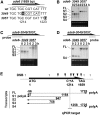Correlation of Meiotic DSB Formation and Transcription Initiation Around Fission Yeast Recombination Hotspots
- PMID: 28396503
- PMCID: PMC5499187
- DOI: 10.1534/genetics.116.197954
Correlation of Meiotic DSB Formation and Transcription Initiation Around Fission Yeast Recombination Hotspots
Abstract
Meiotic homologous recombination, a critical event for ensuring faithful chromosome segregation and creating genetic diversity, is initiated by programmed DNA double-strand breaks (DSBs) formed at recombination hotspots. Meiotic DSB formation is likely to be influenced by other DNA-templated processes including transcription, but how DSB formation and transcription interact with each other has not been understood well. In this study, we used fission yeast to investigate a possible interplay of these two events. A group of hotspots in fission yeast are associated with sequences similar to the cyclic AMP response element and activated by the ATF/CREB family transcription factor dimer Atf1-Pcr1. We first focused on one of those hotspots, ade6-3049, and Atf1. Our results showed that multiple transcripts, shorter than the ade6 full-length messenger RNA, emanate from a region surrounding the ade6-3049 hotspot. Interestingly, we found that the previously known recombination-activation region of Atf1 is also a transactivation domain, whose deletion affected DSB formation and short transcript production at ade6-3049 These results point to a possibility that the two events may be related to each other at ade6-3049 In fact, comparison of published maps of meiotic transcripts and hotspots suggested that hotspots are very often located close to meiotically transcribed regions. These observations therefore propose that meiotic DSB formation in fission yeast may be connected to transcription of surrounding regions.
Keywords: DNA double-strand break formation; chromatin; meiosis; meiotic recombination; transcription.
Copyright © 2017 by the Genetics Society of America.
Figures






Similar articles
-
The histone variant H2A.Z promotes initiation of meiotic recombination in fission yeast.Nucleic Acids Res. 2018 Jan 25;46(2):609-620. doi: 10.1093/nar/gkx1110. Nucleic Acids Res. 2018. PMID: 29145618 Free PMC article.
-
Multiple modes of chromatin configuration at natural meiotic recombination hot spots in fission yeast.Eukaryot Cell. 2007 Nov;6(11):2072-80. doi: 10.1128/EC.00246-07. Epub 2007 Sep 7. Eukaryot Cell. 2007. PMID: 17827346 Free PMC article.
-
Distinct regions of ATF/CREB proteins Atf1 and Pcr1 control recombination hotspot ade6-M26 and the osmotic stress response.Nucleic Acids Res. 2008 May;36(9):2838-51. doi: 10.1093/nar/gkn037. Epub 2008 Mar 29. Nucleic Acids Res. 2008. PMID: 18375981 Free PMC article.
-
The conserved histone variant H2A.Z illuminates meiotic recombination initiation.Curr Genet. 2018 Oct;64(5):1015-1019. doi: 10.1007/s00294-018-0825-9. Epub 2018 Mar 16. Curr Genet. 2018. PMID: 29549582 Review.
-
Regulation Mechanisms of Meiotic Recombination Revealed from the Analysis of a Fission Yeast Recombination Hotspot ade6-M26.Biomolecules. 2022 Nov 26;12(12):1761. doi: 10.3390/biom12121761. Biomolecules. 2022. PMID: 36551189 Free PMC article. Review.
Cited by
-
DNA sequence differences are determinants of meiotic recombination outcome.Sci Rep. 2019 Nov 11;9(1):16446. doi: 10.1038/s41598-019-52907-x. Sci Rep. 2019. PMID: 31712578 Free PMC article.
-
Multi-Layered Regulations on the Chromatin Architectures: Establishing the Tight and Specific Responses of Fission Yeast fbp1 Gene Transcription.Biomolecules. 2022 Nov 5;12(11):1642. doi: 10.3390/biom12111642. Biomolecules. 2022. PMID: 36358992 Free PMC article. Review.
-
Where to Cross Over? Defining Crossover Sites in Plants.Front Genet. 2018 Dec 12;9:609. doi: 10.3389/fgene.2018.00609. eCollection 2018. Front Genet. 2018. PMID: 30619450 Free PMC article. Review.
-
The histone variant H2A.Z promotes initiation of meiotic recombination in fission yeast.Nucleic Acids Res. 2018 Jan 25;46(2):609-620. doi: 10.1093/nar/gkx1110. Nucleic Acids Res. 2018. PMID: 29145618 Free PMC article.
-
lncRNA transcription induces meiotic recombination through chromatin remodelling in fission yeast.Commun Biol. 2021 Mar 5;4(1):295. doi: 10.1038/s42003-021-01798-8. Commun Biol. 2021. PMID: 33674718 Free PMC article.
References
-
- Borde V., de Massy B., 2013. Programmed induction of DNA double strand breaks during meiosis: setting up communication between DNA and the chromosome structure. Curr. Opin. Genet. Dev. 23: 147–155. - PubMed
-
- Borde V., Goldman A. S., Lichten M., 2000. Direct coupling between meiotic DNA replication and recombination initiation. Science 290: 806–809. - PubMed
MeSH terms
Substances
LinkOut - more resources
Full Text Sources
Other Literature Sources

